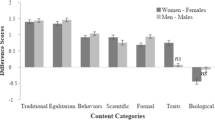Abstract
The present investigation focused upon the impact of gender and various “powerful” and “less powerful” linguistic features on the communication of unfamiliar male and female college students. Same-sex and mixed-sex dyads were recorded as they engaged in discussions regarding suggestions for a bogus freshman orientation booklet. Although few gender differences were found, the result of a factor analysis yielded three factors: questions, suggestions, and process variables. These factors are consistent with a power perspective in the use of various linguistic features. However, the present findings suggest that gender and power alone cannot explain differences in communication styles. Rather, the results suggest the need to consider other aspects of the speaker to explain differences that occur in the use of language.
Similar content being viewed by others
References
Bernard J. (1968). The sex game. Englewood Cliffs, NJ: Prentice-Hall.
Bradley, P. H. (1981). The folk-linguistics of women's speech: An empirical examination. Communication Monographs, 48, 73–90.
Brouwer, D., Gerritsen, M., & De Haan, D. (1979). Speech differences between women and men: On the wrong track? Language in Society, 8, 33–50.
Crosby, F., & Nyquist, L. (1977). The female register: An empirical study of Lakoff's hypothesis. Language in Society, 6, 313–322.
Drass, K. A. (1986). The effect of gender identity on conversation. Social Psychology Quarterly, 294–301.
Dubois, B. L., & Crouch, I. (1975). The question of tag questions in women's speech: They don't really use more of them, do they? Language in Society, 4, 289–294.
Eakins, B. W., & Eakins, R. G. (1978). Sex differences in human communication. Boston: Houghton Mifflin.
Edelsky, C. (1979). Question intonation and sex roles. Language in Society, 8, 15–32.
Fishman, P. M. (1978a). Interaction: The work women do. Social Problems, 25, 397–406.
Fishman, P. M. (1978b). What do couples talk about when they're alone? In D. Butturff & E. L. Epstein (Eds.); Women's language style. Akron, OH: University of Akron Press.
Gorsuch, R. L. (1983). Factor Analysis (2nd ed.). Hillsdale, NJ: Erlbaum.
Haas, A. (1979). Male and female spoken language differences: Stereotypes and evidence. Psychological Bulletin, 86, 616–626.
Kennedy, C. W., & Camden, C. T. (1981). Gender differences in interrupting behavior: A dominance perspective. International Journal of Women's Studies, 4, 135–142.
Kollack, P., Blumstein, P., & Schwartz, P. (1985). Sex and power in interaction. American Sociological Review, 50, 34–46.
Lakoff, R. T. (1975). Language and women's place. New York: Harper Colophon Books.
McConnell-Ginet, S. (1975). Our father tongue: Essay in linguistic politics. Diacritics, 5, 44–50.
McLaughlin, M. L., Cody, M. J., Kane, M. L., & Robey, C. S. (1981). Sex differences in story receipt and story sequencing behaviors in dyadic conversations. Human Communication Research, 7, 99–116.
McMillan, J. R., Clifton, A. K., McGrath, D., & Gale, W. S. (1977). Women's language: Uncertainty or interpersonal sensitivity and emotionality? Sex Roles, 3, 545–559.
O'Barr, W. M., & Atkins, B. K. (1980). “Women's language” or “powerless language”? In S. McConnell-Ginet, R. Borker, & N. Furman (Eds.), Women and language in literature and society. New York: Praeger.
Parsons, T., & Bales, R. F. (1955). Family, socialization, and interaction process. New York: The Free Press.
Rummel, R. T. (1970). Applied factor analysis. Evanston, Ill: Northwestern University Press.
Soskin, W. F., & John, V. P. (1963). The study of spontaneous talk. In R. Barker (Ed.), The stream of behavior. New York: Appleton-Century-Crofts.
Strodtbeck, F. L., & Mann, R. D. (1956). Sex role differentiation in jury deliberations. Sociometry, 19, 3–11.
Tannen, D. (1984). Conversational style. Analyzing talk among friends. Norwood, New Jersey: Ablex.
Thorne, B., & Henley, N. (1975). Language and sex: Difference and dominance. Rawley, MA: Newbury House.
Warshay, D. W. (1972). Sex differences in language style. In C. Safilios-Rothschild (Ed.), Toward a sociology of women. Lexington, MA: Xerox Publishing.
West, C. (1982). Why can't a woman be more like a man? Work and Occupations, 9, 5–29.
West, C., & Zimmerman, D. H. (1977). Women's place in everyday talk: Reflections on parent-child interaction. Social Problems, 24, 521–529.
Author information
Authors and Affiliations
Rights and permissions
About this article
Cite this article
Simkins-Bullock, J.A., Wildman, B.G. An investigation into the relationships between gender and language. Sex Roles 24, 149–160 (1991). https://doi.org/10.1007/BF00288888
Issue Date:
DOI: https://doi.org/10.1007/BF00288888




